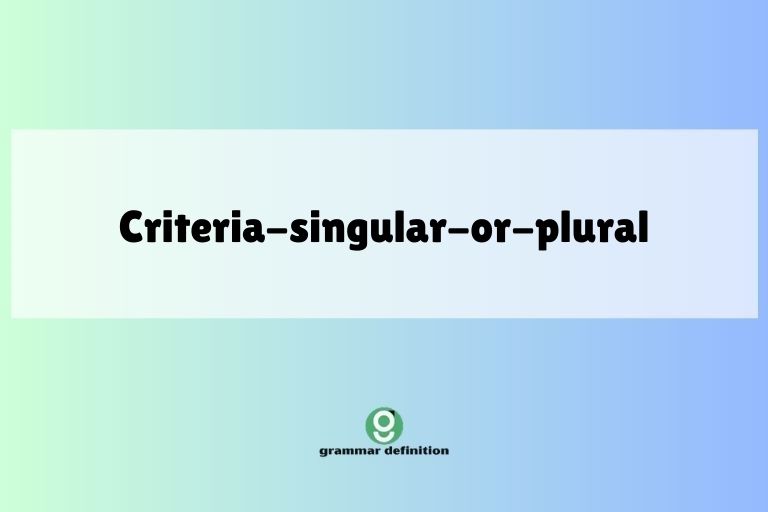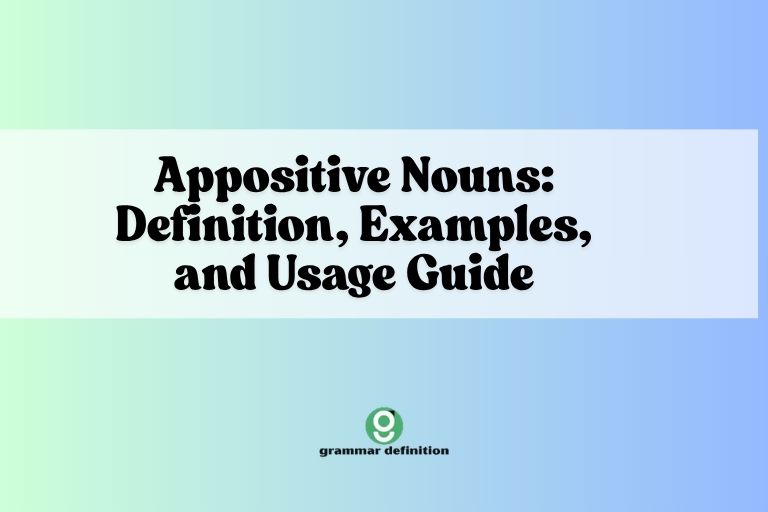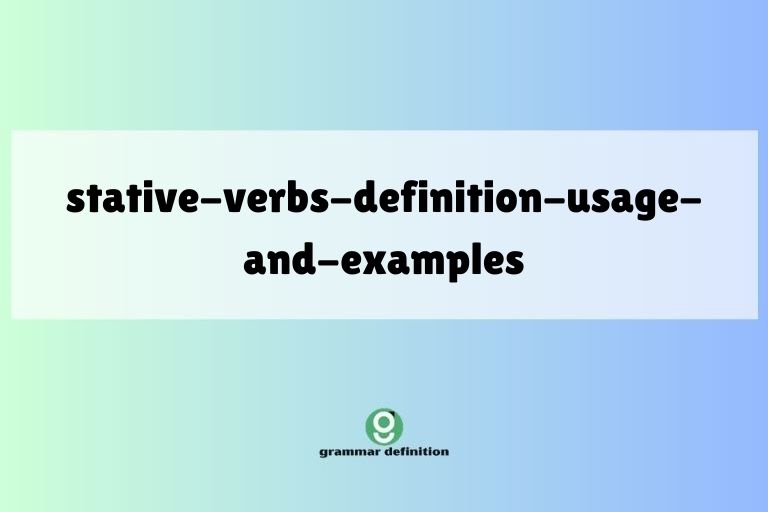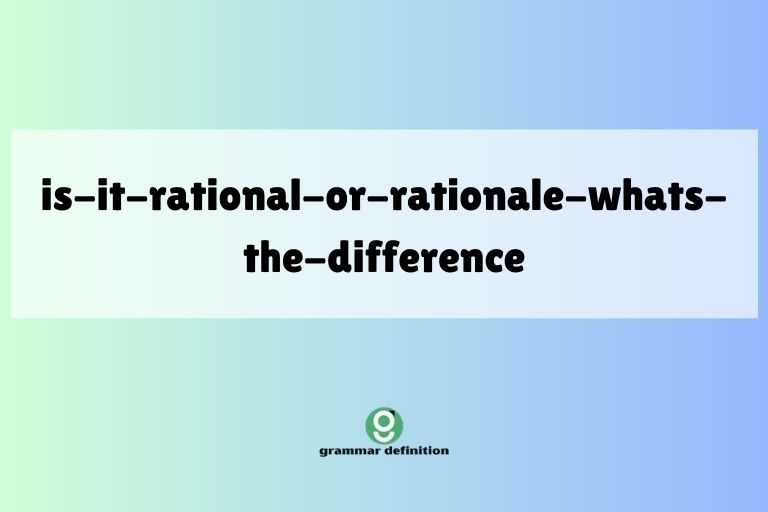Oases or Oasises: Mastering the Plural of Oasis
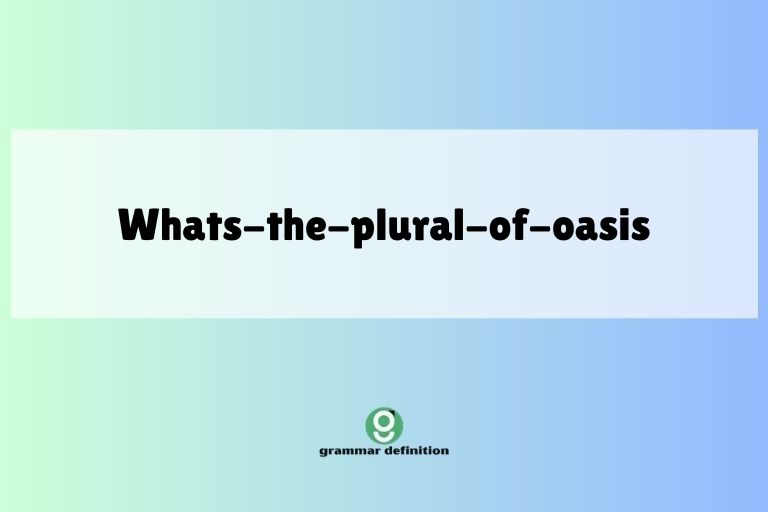
Understanding how to pluralize nouns correctly is a crucial aspect of English grammar. One word that often causes confusion is “oasis.” Is the plural “oases” or “oasises”?
This article will delve into the etymology, grammatical rules, and proper usage of the plural form of “oasis,” providing comprehensive explanations and examples to help you master this concept. Whether you’re a student, a writer, or simply someone who wants to improve their English skills, this guide will offer valuable insights and practical exercises to enhance your understanding.
Table of Contents
- Introduction
- Definition of Oasis
- Etymology and Linguistic Roots
- Grammatical Classification
- Plural Formation in English
- Regular vs. Irregular Plurals
- The Plural of Oasis: Oases
- Why “Oases” is the Correct Plural
- Common Mistakes: Oasises vs. Oases
- Examples of “Oases” in Sentences
- Examples in Literature
- Examples in Geography and Travel Writing
- Usage Rules for “Oases”
- Exceptions and Special Cases
- Formal vs. Informal Usage
- Regional Variations
- Practice Exercises
- Exercise 1: Fill in the Blanks
- Exercise 2: Correct the Sentences
- Exercise 3: Multiple Choice
- Advanced Topics
- Loanwords and Pluralization
- Linguistic Analysis of Plural Formation
- Frequently Asked Questions (FAQ)
- Conclusion
Introduction
The English language, with its rich history and diverse influences, often presents learners with tricky grammatical nuances. One such nuance lies in the pluralization of certain nouns, particularly those borrowed from other languages.
The word “oasis,” referring to a fertile spot in a desert where water is found, is a prime example. Knowing the correct plural form, “oases,” is essential for accurate and effective communication.
This article aims to provide a comprehensive guide to understanding and using the plural of “oasis” correctly.
Definition of Oasis
An oasis is a fertile area in a desert or semi-desert environment where water is available. This water source can be a spring, well, or other underground source, allowing plants and animals to thrive. Oases are often vital for human settlements and trade routes in arid regions, providing essential resources for survival.
Etymology and Linguistic Roots
The word “oasis” comes to English from Greek. The Greek word ὄασις (oasis) is itself believed to have originated from an Egyptian word referring to a dwelling place. This journey through languages highlights the importance of oases throughout history and across different cultures.
Grammatical Classification
In English grammar, “oasis” is classified as a common noun. More specifically, it is a singular count noun, meaning it refers to a single, countable entity. Its plural form, “oases,” denotes multiple instances of these fertile areas.
Plural Formation in English
English plural formation generally involves adding “-s” or “-es” to the end of a singular noun. However, many nouns, especially those of foreign origin, follow different rules.
Understanding these rules is essential for accurate grammar.
Regular vs. Irregular Plurals
Regular plurals are formed by adding “-s” (e.g., “book” becomes “books”) or “-es” (e.g., “box” becomes “boxes”) to the singular noun. Irregular plurals, on the other hand, follow different patterns, often due to their historical origins. Examples of irregular plurals include “child” (children), “mouse” (mice), and “oasis” (oases).
The Plural of Oasis: Oases
The correct plural form of “oasis” is oases. This follows a pattern common to some nouns of Greek or Latin origin, where the singular ending “-is” changes to “-es” in the plural. Other examples of this pattern include “analysis” (analyses), “crisis” (crises), and “thesis” (theses).
Why “Oases” is the Correct Plural
The pluralization of “oasis” to “oases” is rooted in its Greek origin and the established rules for pluralizing words ending in “-is.” Attempting to pluralize it as “oasises” would be incorrect according to standard English grammar conventions. It’s essential to remember that many borrowed words retain elements of their original language’s grammatical structure.
Common Mistakes: Oasises vs. Oases
A common mistake is to pluralize “oasis” as “oasises,” likely because many English nouns form their plural by adding “-es.” However, “oasises” is grammatically incorrect. The correct plural form, “oases,” is the only acceptable option in formal writing and speech.
This table highlights the difference:
| Incorrect | Correct |
|---|---|
| Oasises | Oases |
Examples of “Oases” in Sentences
To illustrate the correct usage of “oases,” here are several examples in sentences. These examples demonstrate how “oases” can be used in various contexts.
| Sentence |
|---|
| The caravan stopped at several oases to replenish their water supplies. |
| Satellite images revealed the locations of hidden oases in the vast desert. |
| The discovery of these oases led to the establishment of new trade routes. |
| Palm trees flourished in the oases, providing shade and sustenance. |
| Many nomadic tribes depend on the oases for their survival. |
| Scientists are studying the unique ecosystems within the desert oases. |
| The ancient Egyptians built settlements near the oases of the Western Desert. |
| The oases served as vital stopping points for travelers crossing the Sahara. |
| Conservation efforts are focused on protecting the fragile environments of these oases. |
| The lush vegetation around the oases contrasted sharply with the barren landscape. |
| The explorer documented the location of several previously unknown oases. |
| These oases provided a sanctuary for wildlife in the arid region. |
| The local communities relied on the water from the oases for irrigation. |
| The oases were a welcome sight after days of traveling through the desert. |
| The map showed the distribution of oases across the desert landscape. |
| The existence of these oases supports a surprising amount of biodiversity. |
| The largest of the oases could support a small village. |
| Legends spoke of hidden oases guarded by ancient spirits. |
| The research team studied the water quality in several oases. |
| The oases provided critical resources for the migrating birds. |
| The fertile land around the oases was used for farming. |
| The presence of oases made trans-Saharan trade possible. |
| The dwindling water supply threatened the survival of several oases. |
| The development projects aimed to improve the infrastructure of the oases. |
| The tour guide pointed out the various plants that thrived in the oases. |
| The oases were a vital part of the region’s cultural heritage. |
| The project sought to sustainably manage the water resources of the oases. |
| The desert animals gathered at the oases to drink. |
| The oases were often depicted in ancient artwork. |
Examples in Literature
In literature, “oases” are often used metaphorically to represent places of refuge or sources of hope in otherwise barren or desolate situations. Here are a few hypothetical examples:
| Sentence |
|---|
| In the protagonist’s bleak existence, moments of kindness were like oases in a vast desert. |
| The library became one of the intellectual oases for the community, offering solace and enlightenment. |
| For the weary traveler, the small inn was an oases of comfort and rest. |
| The artist found inspiration in the quiet oases of his studio, far from the city’s noise. |
| Her friendships were oases of support during her difficult times. |
| The community garden served as one of the few green oases in the concrete jungle. |
| The old bookstore was one of the literary oases in town. |
| The summer camp became one of the joyful oases for the children, away from their troubles. |
| The meditation retreat offered oases of calm amidst the chaos of daily life. |
| The museum was one of the cultural oases for the city’s art enthusiasts. |
| The small park became one of the few natural oases in the industrial area. |
| The music school served as one of the creative oases for aspiring musicians. |
| His weekly visits to the elderly were oases of companionship in their loneliness. |
| The theater group provided oases of entertainment for the local community. |
| The writing workshop became one of the intellectual oases for budding authors. |
| The volunteer center acted as oases of hope for those in need. |
| The nature preserve was one of the few ecological oases in the region. |
| The art gallery served as one of the visual oases for art lovers. |
| The community center became one of the social oases for the neighborhood. |
| The botanical garden was one of the peaceful oases for city dwellers. |
| The poetry club offered oases of expression for creative writers. |
| The spiritual center provided oases of reflection for its members. |
| The after-school program became one of the safe oases for children in the area. |
| The support group offered oases of understanding for those struggling with grief. |
| The dance studio served as one of the artistic oases for talented performers. |
| The historical society acted as one of the cultural oases for the region. |
| The environmental organization worked to protect the natural oases of the area. |
| The science museum became one of the educational oases for students. |
| The cooking class offered oases of culinary creativity for food enthusiasts. |
Examples in Geography and Travel Writing
In geographical and travel writing contexts, “oases” are discussed as real, physical locations. Here are some examples:
| Sentence |
|---|
| The Siwa Oases in Egypt are known for their date palm groves and olive trees. |
| The Turpan Oases in China have been important agricultural centers for centuries. |
| The Ubari Oases in Libya are famous for their beautiful lakes surrounded by sand dunes. |
| Visiting the oases of Morocco offers a glimpse into traditional Berber culture. |
| The Ghardaïa Oases in Algeria are a UNESCO World Heritage site, known for their unique architecture. |
| The Timimoun Oases in Algeria are characterized by their red ochre buildings. |
| The Al Ain Oases in the United Arab Emirates showcase traditional farming practices. |
| The Huacachina Oases in Peru is a popular tourist destination, known for sandboarding. |
| The Crescent Lake Oases in China is a scenic spot surrounded by towering sand dunes. |
| The Farafra Oases in Egypt are known for their unique rock formations and hot springs. |
| The Bahariya Oases in Egypt are famous for their ancient tombs and Roman ruins. |
| The Kharga Oases in Egypt are the largest of the Western Desert oases. |
| The Dakhla Oases in Egypt are known for their well-preserved mud-brick houses. |
| The Fayyum Oases in Egypt are famous for their fertile land and agricultural production. |
| The M’zab Oases in Algeria are known for their traditional Berber architecture. |
| The Figuig Oases in Morocco are known for their extensive date palm plantations. |
| The Tafilalt Oases in Morocco are one of the largest oases in the world. |
| The Tinghir Oases in Morocco are known for their stunning Todra Gorge. |
| The Ziz Oases in Morocco are known for their dramatic canyons and palm groves. |
| The Erfoud Oases in Morocco are known for their fossil finds and desert landscapes. |
| The Azraq Oases in Jordan are an important stopover for migrating birds. |
| The desert expedition aimed to map the locations of undiscovered oases. |
| The travel blogger described her experience visiting the remote oases in the Sahara. |
| The guide led the tourists through the network of oases in the region. |
| The conservation project focused on protecting the endangered species in the oases. |
| The research team studied the water resources and ecosystems of the oases. |
| The documentary showcased the unique culture of the people living in the oases. |
Usage Rules for “Oases”
The primary rule for using “oases” is to ensure it is used as the plural form of “oasis.” Always use “oases” when referring to more than one oasis. Consistency in using the correct plural form is crucial for clear communication.
Exceptions and Special Cases
There are no exceptions to the rule that “oases” is the plural of “oasis.” While some irregular plurals may have alternative forms, “oases” is the universally accepted and correct plural. The word “oasises” is not considered valid.
Formal vs. Informal Usage
The use of “oases” is appropriate in both formal and informal contexts. There is no distinction between formal and informal usage for this word; “oases” is the standard plural form in all situations.
Regional Variations
There are no significant regional variations in the usage of “oases.” The plural form “oases” is consistent across different English-speaking regions, including the United States, the United Kingdom, Canada, and Australia.
Practice Exercises
To reinforce your understanding of the plural form of “oasis,” complete the following exercises. These exercises will test your knowledge and help you practice using “oases” correctly.
Exercise 1: Fill in the Blanks
Fill in the blanks with the correct plural form of “oasis” (“oases”).
| Question | Answer |
|---|---|
| 1. The caravan stopped at several _______ to replenish their water. | oases |
| 2. The map showed the location of many _______ in the Sahara Desert. | oases |
| 3. These _______ are critical for the survival of desert wildlife. | oases |
| 4. The explorer discovered a cluster of hidden _______. | oases |
| 5. The tour guide led us through the beautiful _______. | oases |
| 6. The ancient trade routes relied on the presence of _______. | oases |
| 7. We marveled at the lush vegetation in the _______. | oases |
| 8. The project aimed to protect the endangered species in the _______. | oases |
| 9. The discovery of new _______ could transform the region. | oases |
| 10. The local communities depend on the water from the _______. | oases |
Exercise 2: Correct the Sentences
Correct the following sentences, ensuring the plural form of “oasis” is used correctly.
| Incorrect Sentence | Correct Sentence |
|---|---|
| 1. The caravan stopped at several oasises. | The caravan stopped at several oases. |
| 2. The map showed the location of many oasises in the Sahara Desert. | The map showed the location of many oases in the Sahara Desert. |
| 3. These oasises are critical for the survival of desert wildlife. | These oases are critical for the survival of desert wildlife. |
| 4. The explorer discovered a cluster of hidden oasises. | The explorer discovered a cluster of hidden oases. |
| 5. The tour guide led us through the beautiful oasises. | The tour guide led us through the beautiful oases. |
| 6. The ancient trade routes relied on the presence of oasises. | The ancient trade routes relied on the presence of oases. |
| 7. We marveled at the lush vegetation in the oasises. | We marveled at the lush vegetation in the oases. |
| 8. The project aimed to protect the endangered species in the oasises. | The project aimed to protect the endangered species in the oases. |
| 9. The discovery of new oasises could transform the region. | The discovery of new oases could transform the region. |
| 10. The local communities depend on the water from the oasises. | The local communities depend on the water from the oases. |
Exercise 3: Multiple Choice
Choose the correct plural form of “oasis” in each sentence.
| Question | Options | Answer |
|---|---|---|
| 1. The desert is dotted with several ______. | (a) oasis (b) oases (c) oasises | (b) oases |
| 2. These ______ provide a vital water source for nomads. | (a) oasis (b) oases (c) oasises | (b) oases |
| 3. The expedition explored the remote ______. | (a) oasis (b) oases (c) oasises | (b) oases |
| 4. The map clearly marked the location of the ______. | (a) oasis (b) oases (c) oasises | (b) oases |
| 5. The traveler was relieved to find ______. | (a) oasis (b) oases (c) oasises | (b) oases |
| 6. Many species of birds migrate to these ______. | (a) oasis (b) oases (c) oasises | (b) oases |
| 7. The study focused on the ecology of the ______. | (a) oasis (b) oases (c) oasises | (b) oases |
| 8. The local culture is deeply connected to the ______. | (a) oasis (b) oases (c) oasises | (b) oases |
| 9. The conservation project aims to preserve the ______. | (a) oasis (b) oases (c) oasises | (b) oases |
| 10. The village thrived thanks to the nearby ______. | (a) oasis (b) oases (c) oasises | (b) oases |
Advanced Topics
For advanced learners, understanding the nuances of loanword pluralization and linguistic analysis can provide a deeper appreciation of English grammar.
Loanwords and Pluralization
English has borrowed words from numerous languages, each with its own rules for pluralization. Some loanwords retain their original plural forms (like “curriculum” becoming “curricula”), while others are anglicized and follow English pluralization rules.
Knowing the origin of a word can often help determine its correct plural form.
Linguistic Analysis of Plural Formation
Linguistic analysis of plural formation involves examining the historical and structural patterns of how plurals are formed in a language. This includes studying the phonological and morphological changes that occur when nouns are pluralized, as well as the factors that influence the choice between regular and irregular plural forms.
Frequently Asked Questions (FAQ)
Here are some frequently asked questions about the plural of “oasis” to further clarify any remaining doubts.
- Is “oasises” ever correct?
No, “oasises” is not a correct plural form of “oasis.” The only accepted plural form is “oases.” Using “oasises” would be considered a grammatical error.
- Why does “oasis” have an irregular plural?
The irregular plural “oases” is due to the word’s Greek origin. In Greek, words ending in “-is” often form their plural by changing the ending to “-es.” English has retained this pattern for some words of Greek origin, including “oasis.”
- Are there other words that follow the same pluralization rule as “oasis”?
Yes, several other words of Greek origin follow the same pluralization rule. Examples include “analysis” (analyses), “crisis” (crises), “hypothesis” (hypotheses), and “thesis” (theses).
- Can I use “oasis” as a collective noun to refer to multiple oases?
While it might be tempting to use “oasis” as a collective noun, it’s generally not considered standard English. It is always best to use the plural form “oases” when referring to more than one oasis.
- Is the pronunciation of “oases” different from “oasis”?
Yes, the pronunciation changes slightly. “Oasis” is typically pronounced as /oʊˈeɪsɪs/, while “oases” is pronounced as /oʊˈeɪsiːz/ or /oʊˈeɪsiːs/.
- How can I remember that the plural of “oasis” is “oases”?
One helpful way to remember is to associate “oasis” with other similar words like “analysis” and “crisis,” which also change their “-is” ending to “-es” in the plural.
- Does the context change the pluralization of “oasis”?
No, the context does not change the pluralization. Regardless of the sentence or situation, the correct plural form of “oasis” remains “oases.”
- What resources can I use to further improve my understanding of English pluralization rules?
There are many online grammar resources, textbooks, and language learning apps that can help you improve your understanding of English pluralization rules. Consulting a dictionary is also a good practice.
Conclusion
Mastering the plural form of “oasis” is a simple yet important step in improving your English grammar skills. Remember that the correct plural is “oases,” following the pattern of Greek-origin words ending in “-is.” By understanding the etymology, grammatical rules, and common mistakes associated with this word, you can confidently use it in your writing and speech.
Consistent practice and attention to detail will help solidify your knowledge and prevent future errors. Keep practicing, and you’ll find navigating the intricacies of English grammar becomes easier with each lesson.

